|
THE TOWN HALL CLOCK
By Harold Gibson
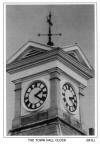 Some
four years after the present Town Hall was built the Clock
was installed in the turret as a gift to the townspeople by
Mr. William Cowan Heron. In January 1891 Cowan Heron was
presented with an illuminated address by the people of
Dromore as a thank you token for his generous gift of the
clock. The address hangs inside the Cottage Hospital along
with his portrait. It would appear from the text of the
address that there were several reasons why the gift of the
clock gave pleasure. As to why the clock was not installed
in the tower when the building was completed in 1886 becomes
apparent as the address is read in full. It would appear
that even with the powers granted to the Town Commissioners
they hesitated at incurring any further expense to the
townspeople by purchasing a clock for the tower and thus
providing a benefit to the town. The text goes on to thank
the Cowan Heron Family for the gift of the clock and to say
that as time flies, the added appearance to the Town
Hall will serve as a reminder of the donor. Some
four years after the present Town Hall was built the Clock
was installed in the turret as a gift to the townspeople by
Mr. William Cowan Heron. In January 1891 Cowan Heron was
presented with an illuminated address by the people of
Dromore as a thank you token for his generous gift of the
clock. The address hangs inside the Cottage Hospital along
with his portrait. It would appear from the text of the
address that there were several reasons why the gift of the
clock gave pleasure. As to why the clock was not installed
in the tower when the building was completed in 1886 becomes
apparent as the address is read in full. It would appear
that even with the powers granted to the Town Commissioners
they hesitated at incurring any further expense to the
townspeople by purchasing a clock for the tower and thus
providing a benefit to the town. The text goes on to thank
the Cowan Heron Family for the gift of the clock and to say
that as time flies, the added appearance to the Town
Hall will serve as a reminder of the donor.
Some 103 years after its installation the clock is still
going though it has had a long and sometimes arduous history
as many down through the years have sought to keep this time
piece going with a degree of accuracy. A series of articles
entitled "Historic Clocks of Down" by W. H. Carson and
published in the Mourne Observer carries a feature on the
Dromore Town Clock in its' issue dated 11th May, 1978. From
that article we glean that Berringer Bros., of Belfast were
the contractors who erected the clock in the turret and M.
Byrne of the Fountain Head Bell Foundry, Dublin, cast and
hung the clock bell. Whilst Berringer Bros. were not turret
clock makers it is presumed that the clock would have been
brought in from one of the turret clock makers in England.
The style of the clock consists of four white faces each
having a diameter of 44 inches and the black hands measuring
18 in and 12 in. The hours are in black roman numerals.
The clock faces light at night and the clock strikes the
hours in a light tenor note. The dial facing Church Street
has a patch between the hours of 3 and 4 believed to date
from a night in 1920 when it is said that the "B" Specials
put a bullet into the clock.
The maintenance of such a timepiece has not been easy and
it is a tough piece of mechanism to wind up. This particular
clock was fitted with a heavy winding action not to mention
the fact that access to the machinery necessitated climbing
two perpendicular iron ladders into the turret. Part of the
recent history of the clock can be traced from the names
written upon a wooden beam in the turret where the clock
sits inside a glass fronted cupboard below the bell. Sharman
D. Neill, the large Belfast jeweller of a bygone age carried
out an alteration to the dial in November 1949 and
mechanical repairs on the 14th December, 1949. At one time
the clock custodian was Herbert Silcock who was waterman and
water rate collector to the former Urban District Council.
Mr. Silcock's name together with that of T. R. Armstrong and
his son Bertie, jewellers and watchmakers of Market Square,
Dromore appear on the turret timbers. One other inscription
reads "Clock repaired July 1963" and simply signed with the
letter "H".
At one time it was suggested that a possible
electrification of the clock would overcome the weekly climb
into the turret to crank up the old timepiece. Herbert
Silcock was in favour of the proposal and Albert Cairns the
town clerk agreed with him but before a decision was taken
Mr. Cairns called David McClenaghan of Drumbroneth, a
mechanical clock expert who saved the timepiece from the
final indignity of electrification. Mr. McClenaghan altered
the weight on time mechanism, ground in new bearings and
overhauled the drive. The clock had got a new lease of life
though for those who maintained it may have thought that
electrification would have made life a little easier.
At one time the Town Hall could boast of having two
bells. During the days of the pig market a bell that hung at
the rear of the Town Hall on the outside back wall was rung
every Wednesday at 9 a.m. to announce the opening of the
market. The Market Bell had a hanging chain attached to a
bracket on the wall and Willie Corbett and Willie Bradshaw
were the bell ringers. (A photograph of the pig market
dating from around 1905 appears on page 28 of Vol. 2 of the
Journal and the bell can be seen quite clearly.) The market
Bell was also used in former days to call out the Fire
Brigade.
One of the many problems facing those who looked after
the Town Hall clock was the difficulty in keeping all four
faces giving the same time. No doubt the saying, "He has as
many faces as the town hall clock" arose from this
situation. Over the years the clock had developed a ten
minute time variation between the four dials, a common
complaint with four faced turret clocks usually caused by
the friction of dust mixed with lubricating oil on the
moving parts. In the mid 1970's repairs were undertaken by
John Curl from Lisburn who had a particular interest in
mechanical clocks. The timepiece was dismantled and cleaned
and since that time the four faces have been in close
agreement. When the new library was being fitted out in the
Town Hall one of the cables holding the timing weight was
knocked off its pulley and the cable snapped. Again Mr. Curl
was called in and he carried out the repairs. During the
70's the caretaker of the Town Hall was Samuel Gribben of
Maypole Park. Every Thursday at 12.30 p.m. Sam climbed the
turret to wind the clock. Today the clock is still going and
that tenor note still rings out from the bell though the
faces do not appear to be lit at night. The maintenance of
the clock is now the responsibility of Banbridge District
Council and the timepiece that has served Dromore for over
100 years still chimes out the hours giving the time and
calling to remembrance the donor William Cowan Heron.
Time, like an ever rolling
stream
bears all her sons away,
they fly forgotten as a dream
dies at the opening day.
-Isaac Watts 1674-1748.

LAMENT
FOR A LANDMARK
By Rosemary McMillan
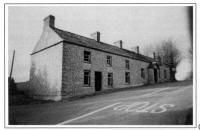 |
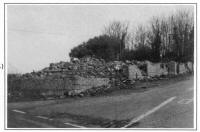 |
|
Photographs by courtesy of Martin
Campbell and Howard Kinkead. |
Over the past few years, this well known building at
Agnews Corner had slowly deteriorated. Vandalism had
hastened the process, but it still remained a landmark by
which to give directions. The dark, welcoming shape, on a
cold snowy night, signalled for me, the last half mile home.
The old building is shown on a map of the townland of
Coolsallagh, made by the Ordnance Survey of Ireland on
February 28th 1835. Be that as it may, last winter saw the
demise of the dwelling. Fire and subsequent bulldozing,
reduced it to a pile of rubble a chapter in the story had
come to an end.
Those of us who remember Liza, Dick and Sammy have been
made sharply aware of our own mortality, so we welcome the
signs of a new landmark gradually emerging from the debris.
DROMORE FIRE
BRIGADE PAST AND PRESENT
By Cecil Whan
Dromore can proudly boast of having one of the most
spacious fire stations in Northern Ireland. The 19 year old
building is set in almost three quarters of an acre of land
on the Town's Ballynahinch Road. A large carpark provides
ample space for fire-fighters hurrying to answer fire calls.
The Ballynahinch Road is the fourth location for the Dromore
Fire Station in under half a century.
During the early years of the 20th century the local
brigade had access to a council owned fire cart. During the
second world war it became the Auxiliary Fire Service and
the men were given a Morris car and light trailer pump which
was later replaced by a Ford V8 converted tender and trailer
pump. In those days the station was located in what was
known as Hill's entry.
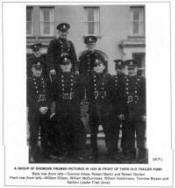 During
the blitz on Belfast the Dromore Auxiliary Fire Service was
despatched to the city to help deal with the damage and
devastation caused by German Bombers. Those who assisted
with the fires in Belfast were; leading Firemen Fred Jones
(Officer in Charge) and the following Firemen - Henry
Johnston, Walter Peden, William Ellison, Robert Gordon,
Herbert Greer, James Greer, Thomas Arlow, William Maginess,
Robert Martin, Robert Jones, John Clokey, Patsy Neeson,
Norman Jamison, Lyle McGuigan, William Herron and Wilfred
Taylor. During
the blitz on Belfast the Dromore Auxiliary Fire Service was
despatched to the city to help deal with the damage and
devastation caused by German Bombers. Those who assisted
with the fires in Belfast were; leading Firemen Fred Jones
(Officer in Charge) and the following Firemen - Henry
Johnston, Walter Peden, William Ellison, Robert Gordon,
Herbert Greer, James Greer, Thomas Arlow, William Maginess,
Robert Martin, Robert Jones, John Clokey, Patsy Neeson,
Norman Jamison, Lyle McGuigan, William Herron and Wilfred
Taylor.
When the personnel received an Austin Tender with a
Harland pump the new equipment was too large for Hill's
entry. They then moved to a new location in Carlisle's
Coalyard in Church Street.
In 1951 the Dromore Brigade moved to a purpose built
station in Gallows Street and more than 20 years after that
the men were on the move
again - because their station was located in a redevelopment
zone! The present commodious building consists of an
appliance room, Sub Officer's office, duty room, recreation
room, kitchen and communications room as well as showers and
washing facilities. move
again - because their station was located in a redevelopment
zone! The present commodious building consists of an
appliance room, Sub Officer's office, duty room, recreation
room, kitchen and communications room as well as showers and
washing facilities.
At the present time the station has a crew of 13 men who
respond to between 150 - 200 callouts per year. The crew
consists of a Sub Officer, 2 leading firefighters and 10
firefighters. The leading firefighters are - Stephen Sands
and Gary Gibson while the firefighters are - Graham Halliday,
Charlie Black, Jim Gracey, Walter Corbett, Kenny Halliday,
Stephen Moreland, Allister Bingham, Darryl Crookshanks,
Winston Martin and John Moreland.
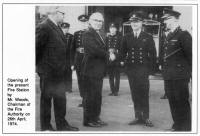 Sub
Officer George Gracey joined the fire service 20 years ago.
He was appointed to the post of Sub Officer in June 1988
following the retirement of Sub Officer Raymond Russell.
Looking back over the years Sub Officer Russell had replaced
Sub Officer Sammy Walker who had in turn taken over from
Cecil Whan (who joined the fire service in 1946). The first
Sub Officer (Known in those days as a Section Leader) was
Fred Jones. Sub
Officer George Gracey joined the fire service 20 years ago.
He was appointed to the post of Sub Officer in June 1988
following the retirement of Sub Officer Raymond Russell.
Looking back over the years Sub Officer Russell had replaced
Sub Officer Sammy Walker who had in turn taken over from
Cecil Whan (who joined the fire service in 1946). The first
Sub Officer (Known in those days as a Section Leader) was
Fred Jones.
Between these 5 men they have given 140 years of
dedication to the Fire Brigade and members of the public.
All have been awarded the Queen's Long Service and Good
Conduct Medal as have other members of the crew. In 1982 Sub
Officer Wham was awarded the British Empire medal for
service to the fire brigade and community at large.

Although now retired Cecil Whan still takes a keen
interest in the fire service and admits that `it's something
that gets in the blood'. He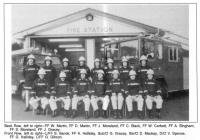 keeps abreast of what is happening at his old station and
has compiled an extensive collection of old photographs and
newspaper cuttings on the Dromore Brigade.
keeps abreast of what is happening at his old station and
has compiled an extensive collection of old photographs and
newspaper cuttings on the Dromore Brigade.
Dromore's territory stretches as far as the Half Way
House (towards Banbridge) and halfway between Lisburn,
Lurgan and Ballynahinch. The Fire-fighters have, however,
travelled as far as Lisnaskea near Enniskillen to assist the
local stations in extinguishing a forest blaze. Occasionally
they also render assistance to nearby stations. During the
height of the `troubles' in the seventies Dromore's fire
crew found themselves answering calls to Lurgan, Lisburn,
Portadown, Armagh, Newry, Dunmurry and Finaghy. These days
the majority of calls attended by the crew are chimney
fires, hay sheds, house fires and road traffic accidents on
the nearby dual carriageway.
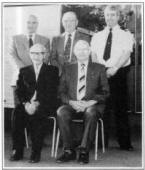 The
station has one fire appliance - A Dennis WRL - one of the
most up to date in the Fire Brigade fleet. The WRL or Water
Tender Ladder carries 400 Gallons of water and an assortment
of Equipment to enable the fire-fighters to deal with fires,
road traffic accidents and chemical incidents. In the event
of a road traffic accident the Dromore appliance is backed
up by an emergency support unit from Lurgan which carries
more specialised cutting equipment. The
station has one fire appliance - A Dennis WRL - one of the
most up to date in the Fire Brigade fleet. The WRL or Water
Tender Ladder carries 400 Gallons of water and an assortment
of Equipment to enable the fire-fighters to deal with fires,
road traffic accidents and chemical incidents. In the event
of a road traffic accident the Dromore appliance is backed
up by an emergency support unit from Lurgan which carries
more specialised cutting equipment.
The crew members meet every Wednesday night from 7.30
p.m. to 9.30 p.m. to practice drills, test equipment and
clean the appliance.
Two special pieces of history live on at the station in
the form of a brass and a chrome bell. During the early part
of the 20th century the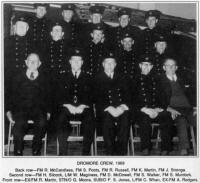 brass bell hung in Dromore Square and was originally used as
a market bell. It later became the primary means of
mobilising the fire crew. In 1974 it was presented to the
crew at the time of the official opening of the new station.
The smaller chrome bell was originally mounted on Dromore's
"Ulster" major pumping appliance. Bells of this type were
the forerunner of the present day two - tone horns. The bell
was rung by the Officer in charge of the appliance en route
to calls to alert the public that a fire appliance was
approaching and also as an indication to the caller that
help was on its way.
brass bell hung in Dromore Square and was originally used as
a market bell. It later became the primary means of
mobilising the fire crew. In 1974 it was presented to the
crew at the time of the official opening of the new station.
The smaller chrome bell was originally mounted on Dromore's
"Ulster" major pumping appliance. Bells of this type were
the forerunner of the present day two - tone horns. The bell
was rung by the Officer in charge of the appliance en route
to calls to alert the public that a fire appliance was
approaching and also as an indication to the caller that
help was on its way.
Dromore fire station - In common with every other station
in the province - has a dedicated, hard-working team who are
always willing to give up their time day or night to assist
people in distress. They can certainly look forward to
creating many more years of history.

The information in this article was
supplied and collated by Cecil Whan B.E.M. Dromore.
|
NEW FIRE STATION OPENED AT
DROMORE
The Leader, Friday, November
23, 1951
Major D. J. Christie, chairman of the
Northern Ireland Fire Authority, apologising for
the absence, through indisposition. Of the Right
Hon. W. B. Maginess, K.C., LL.D., Minister of
Home Affairs, who was to have performed the
ceremony, officially opened a new Fire Station,
erected at a cost of over �6,000, at Upper
Gallows Street. Dromore, beside the auction mart
of Messrs. James Martin R Son, on Friday evening
of last week. There were present:-Messrs. It. C
Montgomery. M.B.E.; R. F. R.. Dunbar. O.B.E.; J.
W. E. Cathcart and L. C. Dennis. of the Ministry
of home Affairs; Messrs. John Reid, J.P.; M.
Busby, .J.P.; R. H. Wright, OBE.' Thos. H.
MacDonald. M.B.E., (town clerk of Lisburn);
Robert Proctor, W. B. O'Donoghue, and James
Finlay, J.P. (vice-chairman), members of the
Northern Ireland Fire Authority, together with a
number of officials, including the secretary,
Mr. H B. Reid. The Dromore Urban Council was
represented by-Mr. Thomas Castles (chairman).
Captain Robt. Johnston (vice-chairman). Messrs.
James Hamilton, Hugh M'Fadden, Lyle M'Guigan,
John Patterson and Francis Russell, with Mr.
Albert Cairns, solicitor (clerk).
A guard of honour, comprised of members of
the local unit of the Fire Authority, under
Fire-Officer V. M'Afee, was inspected by Major
Christie, who was accompanied by Mr. Thos.
Castles, Fire Force Commander G. H. Murphy, and
Chief Officer T. J. Browne, of the Southern Fire
Authority, Portadown.
The visitors were afterwards entertained to
dinner at the Temperance Hotel. Dromore, by the
Chairman and members of the Council.
After toasts to "His Majesty the King" and
'The Governor of Northern Ireland," Mr. Castles.
proposing that of "The government of Northern
Ireland" regretted the absence of Dr. Maginess
and, expressed a hope for his speedy return to
health He welcomed Mr. Montgomery, who had come
In his stead.
Responding. Mr. Montgomery emphasised his
Inability to take the place of Dr. Maginess. He
thought the Government had done a very good job.
They had had a difficult task in maintaining law
and order. He was very pleased to be present on
that auspicious occasion.
Captain Johnston, proposing "The Northern
Ireland Fire Authority," described the new
station as one of the finest he had seen, not
only in design but also in equipment.
Major Christie, on behalf of the Authority.
thanked the Urban Council for their hospitality.
It was rather Interesting, he said, that the
first modern fire station built to the
specification of the new Northern Ireland Fire
Authority was that In Dromore. He paid tribute
to the . work of Mr. D. W. Chambers, A.I.A.S,
Banbridge, architect concerned in the
construction, and Mr. R. Wishart, Carryduff, the
contractor, who were present. He intimated that
a new unit will soon be appearing in Dromore,
costing �3.500. Major Christie went on to speak
of the work of the Authority and of "That worthy
band of chaps," the retained firemen. Speaking
of the International situation, lie said the
response to the appeals for volunteers for the
various Civil Defence Services was very poor
Dromore would probably now get a few more
volunteers for the Fire Service. In conclusion,
Major Christie referred to the co-operation of
Mr. Hugh M'Fadden in the provision of a site,
for the station.

"Town and trade of Dromore" was proposed by
Mr. R. H. Wright, who displayed a knowledge of
the topography and ecclesiastical associations
of the town.
In his reply, Mr. James Hamilton referred-to
the closing down of linen weaving at Holm
Factory: He would like to see the Minister of
Commerce using his good offices to let. Dromore
have a share of any new industries contemplated.
The Guests" was proposed by Mr. Francis
Russell, and responded to by Mr. T. H MacDonald,
who expressed appreciation of the "banquet"
provided. "Dromore is a good town," said Mr.
MacDonald, "and the people progressive. They
have given the Fire Authority every
encouragement, and have reaped the benefit."
Mr. Albert Cairns paid tribute to the help
and co-operation of the secretary of the
Authority (Mr. Reid) in connection with the
opening.
Mr. Chambers presented propelling pencils to
Mr. Castles and Major Christie as mementos of
the occasion, while Mr. Montgomery, on behalf of
Dr. Maginess, received a Parker writing set from
Mr. Wishart.
The new fire station, an imposing building of
red brick with a large double entrance.
comprises, in addition to the lofty central
chamber, or appliance room, a duty room, station
officer's room, store, kitchen, washroom, and
recreation room, as well as adequate toilet
accommodation. Two yards at the rear incorporate
a pettrol store and coal house respectively.
Personnel of the Dromore unit:- Section-Leader
F. S. Jones. Leading-Firemen W. Maginess and C.
Whan. Firemen R. Martin, A. Rodgers, H. Silcock
, W. Taylor, C. Ogle. W. Corbett, G. M'Kee. V.
M'Kee S. Walker, S. G. Poots, J. Ellison and W.
Hutchinson.
Reprinted in The Leader,
8/1/54
The Passing of the old year. 1928. and the
ushering in of the New Year, 1929 was marked by
a serious fire in Market Square, Dromore, when
the drying loft of the dyeworks of the old
-established linen firm of William Jardine & Co.
was destroyed by fire. So menacing was the
outbreak to adjoining property that a phone call
was out put through to the Belfast Fire Brigade
for assistance. and soon a powerful 80 h.p.
engine, with a full complement of men, was
on its way to Dromore. Meanwhile members of the
R.U.C. and a willing band of fire-fighters led
by Sergeant J. W. Tutty. severed adjoining roofs
and managed to keep the conflagration from
spreading to Messers. Jardines Hemstitching
factory and adjoining property including The
Leader Works. When the roof of the drying loft
fell in anxiety was allayed a little, "and when
the fire engine came thundering into The Square
its appearance was heartily welcomed. Soon two
lines of hose were playing on the affected
building, which was still burning fiercely, the
glare illuminating the whale town." The same
night in Great Victoria Street, Belfast the
factory and warehouse of Spence, Bryson & Co.,
Ltd.. linen merchants, was being completely
gutted while part of the Brigade was in Dromore.
Reprinted in Dromore Weekly
Times, 1/12/51
SIDELIGHTS FROM THE PAST
FIFTY YEARS AGO
From "Dromore Weekly Times," of November 30,
1901-
Dromore Fire
On last Saturday morning a serious fire
occurred at the premises of Mr. Jas. Chambers,
Church Street. About 3 a.m. Mr. John Conlon
arrived in Dromore from Belfast with horse and
cart, and noticing a great smoke aroused Mr.
Chambers and his family. Mr, R. H. Hazlette,
attracted by Mr. Conlon's shouting hastily
dressed, ran out and raised further alarm,
ringing the market bell. It was evident that the
store was doomed and at one time it looked as
though the premises of Mr. R. S. Wallace were
also doomed. Mr. John Graham, Jun., Mr. James
Henry Burns, and their men did all in their
power to prevent the flames spreading. The names
of those who assisted were -Thos. Mackin, Robert
.1. Crookshanks, R. Lavery, Alex M'Nally, Samuel
Kilpatrick, Daniel Durkin, Thos. Crookshanks.
Samuel Murdock, Jos. Arbuthnot, W. Magennis,
Thos. Hart, Rev. Dr. Stephenson, and Patrick
Boyle. |

DROMORE .... A
CATHEDRAL CITY
By Rev. T. R. McKnight
There is a legend that when St. Patrick was travelling
from Armagh to Saul he celebrated Holy Communion in a church
four miles distant from Dromore (probably Donaghcloney). The
legend tells us that he saw through the East window a vision
of angels.
They announced to Patrick's host that God had committed
him and his flock to the pastoral rule of a bishop, who
should thereafter found a monastery on that spot. So the
church and the abbey of St. Colman were founded on the site,
Druimmor or Dromore by the bank of the Lagan.
St. Colman is described in Atkinson's, "Dromore, an
Ulster Diocese" as a pupil of St. Mochae, head of the
celebrated monastic school on Mahee Island, Strangford. He
studied under St. Ailbe, Bishop of Munster and established a
monastery at Dromore under St. McNissi, Bishop of Connor.
St. Colman is described in Knox's "History of Co. Down" as:-
"the first bishop of the diocese of Dromore and Abbot of
Dundrum, who was a pupil of St. Caylan, the first bishop of
Down".
As in all early Irish foundations the abbot whether in
Episcopal orders or not, exercised supreme power over the
community.
Rather surprisingly Dromore is not mentioned in the Acts
of the Synod of Rathbreasil in 1110 A.D. Also surprising is
a reference in the Charter of John de Courcy in 1190 to a
certain O'Roney as bishop of Iveagh.
T. E. McNeill's "Anglo Norman Ulster" tells us that when
John de Courcy invaded Ulster (circa 1180) it was divided
into three power blocks, the Cenel Connail; Cenel Eoghain
and Ulaid. Two blocks survived, one which approximated to
the diocese of Dromore which was already spilt between the
McCartan's and Magennises.
In Moody, Martin & O'Byrne's Companion to Irish History
it is recorded that in 1188 Norman soldiers from Dromore
invaded Tir Eogain and Domnall. MacLochlain, king of Cenel
N. Eogain was killed, and was succeeded by his cousin
Muirchertach.
De Courcy had two main power bases, his castles at Dundrum
and Carrickfergus. In addition to these he had a
semi-circular ring of forts of which three bases were
Antrim, Dromore and Maycore sited on the approaches to the
Earldom of Cenel Eoghain.
A garrison of soldiers were retained ready to repel raids
and in the Pipe Roll of 1211 there were thirty men at
Dromore occupying the motte which was one of the three
highest in Ulster.
The garrison soldiers were paid in cows and we know that
by 1252 John Fitz Geoffrey was campaigning in Tir Eogain. We
are also told that Brian O'Neill had submitted and his son
Ruaidri was taken hostage. A new castle had been begun at
Dromore but was destroyed in 1253 by Brian O'Neill.
It is hard to imagine Dromore in the 13th century being
the focal point of power struggles between London and Rome.
During the reign of Edward I, Archbishop Nicholas of Armagh
was deeply involved in the politics of the Anglo-Irish
colony. This happened because of an Episcopal vacancy in
Meath. In spite of it being in the Province of Armagh, it
was very much in the area of strongest English influence and
its bishops had been English or Anglo-Irish since 1194.
In 1252-54 there were two bishops of Meath. The first
one, elected and consecrated with royal assent, the other
one provided by Nicholas and consecrated without royal
assent. The matter was settled by the Pope who favoured the
first, Hugh of Taghman.

Archbishop Nicholas nursed his wounds until Hugh died but
then refused to ratify his successor's appointment. Nicholas
claimed that the appointment lapsed to him as metropolitan
through the neglect of the electors. He duly nominated
Walter of Fulbourn to the vacant See. He was the brother of
the justiciar and treasurer, Stephen of Fulbourn.
However the days of the Fulbourn ascendency were
numbered. Complaints of extortion, and fraud led Edward I to
set up
a commission of enquiry against Stephen. In 1284 they
concluded that the justiciar, Stephen and the Primate,
Nicholas had conspired against the crown.
There were a formidable array of charges against the
Fulbourns. There were two charges against the Archbishop,
one of which concerned the "custody of vacant bishoprics"
one of these bishoprics was Dromore, the other of complicity
in providing Walter of Fulbourn to the diocese of Meath. The
outcome was that great issue was made of the fact that the
excheator of the diocese of Dromore had been expelled by
Nicholas and also a bishop appointed by him.
As a general deduction from this case of Nicholas'
dealing with Dromore it was recommended that:--
"No Irishman should ever be bishop or archbishop because
of their disloyalty and their care to provide to canonries
only those of their own race so that only Irishmen should be
elected bishops". Edward I sought to resolve the dilemma
with a proposal to the Pope to cut the number of Irish
bishoprics by half. He wrote to the Pope as follows:" The
peace and concorde of Ireland is disturbed because Irish
bishops hold Sees adjacent to Irish bishops. These prelates
and their clergy help their own nation by promoting and
encouraging wars against our Lord, King of England and his
subjects. Since the bishoprics of Ireland are very poor and
number 34 a remedy would be to make a union of some of them
and especially that additional bishoprics be annexed to
royal towns in which there are episcopal seats. To the great
security of peace and the King's estate it should be done as
follows . . . . and one of the changes was to the diocese of
Down should be united Dromore".
Ref. The Church and two Nations in Medieval Ireland by
Watt.
The colonial settlement of Ireland was reflected in the
episcopate of mid-13th century Ireland. Of the twenty three
dioceses, thirteen were filled by Anglo-Irish or English
bishops, one by an Italian (Clonfert). Dublin was vacant but
traditionally held by an Englishman. No native Irishman
occupied any of the five dioceses which made up the Dublin
province. In contrast to this in the province of Tuam not a
single Englishman had as yet held a bishopric.
In spite of the Synod of Cashel's (1171) attempts to
bring the Irish electoral system for bishops into line with
England and Edward I's determined efforts to bring four
dioceses, namely Derry; Raphoe; Dromore and Kilmore to
conform, we find that Dromore remained in Irish hands,
uninfluenced by the crown. It was one of seven such in the
Province of Armagh.
The outcome of this state of affairs was that throughout
the 14th century the bishop of Dromore was usually an
absentee English bishop. John Watt says in his book:- "An
indefensible facet of papal policy was its frequent
promotion of English clergy to Irish sees with scant regard
for the good of the diocese concerned, for these bishops had
no intention of residing in their dioceses but rather to
make a career as a suffragan bishop in an English or Welsh
see. The classical example of this abuse occurred in
Dromore."
An interesting situation arises in those who claimed to
be "Bishop of Dromore." An English Benedictine called John
Chourles was suffragan bishop to A/bishop Chichele in
Canterbury 1420-1433. From 1431-1433 two other rival English
friars claimed to have secured papal provision to Dromore.
One was an Augustinian friar called Thomas Radcliff who was
suffragan of Durham. The other was a Carmelite friar, David
Chirbury who was suffragan of St. David's in Wales.

In April 1456 Pope Nicholas V licenses an Irishman called
Donatus Ohendu to be consecrated but he failed to present
himself for consecration within the legal period of twelve
months. In July 1457 Pope Calixtus III provided an English
friar Richard Myssing to Dromore. On that date there was
supposed to be a vacancy caused by the death of Nicholas
Wartree. He had been provided to Dromore in 1419 by Pope
Martin V and had been suffragan bishop of York 1420-1445.
Another Carmelite friar named Thomas Scroppe had been
sent to Dromore by Pope Eugene IV in 1450. He was still
suffragan in York in 1477 and only died in 1499.
Calixtus III had totally ignored Scroppe's appointment in
his provision of Richard Myssing in 1457. When Myssing died
Pope Pius II provided an Augustinian friar, William Egremond
in 1463. He lived until 1501 and acted as suffragan in York
all that time. Meanwhile Pope Sixtus IV provided a Breton to
Dromore in 1480. He was Yvo Guillen, formerly a canon of St.
Malo. In an attempt to resolve the chaos, when Guillen died
in 1483 a canon of All Hallows' in Dublin, George Brana was
appointed. He was a native of Athens but by 1497 was off as
suffragan to the bishops of Worcester and London.
Having failed to secure a solution the Primate wrote to
Henry VIII explaining the situation. He was fearful perhaps
of the presentation of Anglo-French bishops.
His candidate was:
"A bachelor of the Holy Canon Law and a native of the
diocese of Dromore, Arthur Magind (Art MacFlinn)"
The legacy of the 15th century changes now meant that the
bishops were members of both the spiritual and temporal
aristocracies. As such, they held extensive lands and
possessions, and were tenantsin-chief of the Crown.
Therefore no monarch could be indifferent about who was
appointed bishop, because such persons became members of the
ruling class.
Similarly, no pope could be complacent and leave episcopal
appointments entirely in royal hands, lest political
considerations take precedence over ecclesiastical
priorities.
The Primate's letter failed to influence Henry VIII and
in May 1511 Pope Julius II provided an Irish Augustinian
friar to Dromore, called Thady O'Reilly.
Seven years later because of poverty, Dromore was annexed
to the diocese of Ross. Thady was its bishop but after a few
adventures he was excommunicated. Dromore was vacant for 10
years from 1526-36.
Pope Paul III provided an Irish Dominican friar, Quintin
Cogley but he died before being consecrated, and did not
receive royal assent. In 1539 Roger Maccaidh vicar of
Killaic was appointed but resigned immediately. Finally in
April 1540, Pope Paul III provided Art Magennis as bishop.
As early as the 10th century the territory of Iveagh was
known as Magennis country. In those days it suffered from
frequent feuds between the O'Neills, Magennises and
McCartanes.
In 1442 when Arthur Magennis was chief of the clan he
refused to recognise the right of the Archbishop of Armagh
to administer the diocese of Dromore, which was allegedly
vacant. The Archbishop, John Prene denounced him as
"pestilent and sacriligious" as he administered the
territory to his own liking.

Now 98 years later his descendant and namesake was bishop
of Dromore. The wheel had turned full cycle. In spite of all
the English efforts an Irishman was bishop of an Irish
diocese. That diocese was Dromore.
According to Primate Dowdall's Registery, there were only
two Northern dioceses where Henry VIII seems to have made no
provision to establish a bishop of his choice. They were
Derry and Dromore.
The King issued a mandate for the consecration of Primate
Dowdall on 28th November 1543. It is unclear what happened
in Derry but if all the bishops named in the mandate were
present at the ceremony, then Harry could justly maintain,
that he had established his claim to
Royal Supremacy in every diocese of the Province of
Armagh except Dromore. Bishop Arthur Magennis was the last
pre-reformation bishop of Dromore. In the reign of Queen
Eliz. I the head of the clan, Sir. Hugh McEnys is described
by Marshal Bagnal as:- "the civilist of Irish in these parts
... able to field about 60 horsemen and 80 footmen. He
liveth civily and English-like in his own house and every
festival day weareth English garments among his own
followers."
On 10th May, 1550 Bishop Arthur Magennis received a Royal
Pardon for surrendering his Official Bulls and swearing that
he would hold his bishopric from His Majesty alone.
He was therefore the first Protestant Bishop of Dromore
as a result of the Reformation. In 1576 the Pope sent
Patrick Maccaul to be the first bishop of the Roman Catholic
diocese of Dromore. After Arthur's resignation or death
there was another long vacancy. The diocese was in poverty,
the bishop's income was 20 marks whilst the total diocesan
revenues less than 40 pounds.
In 1606 by letters patent with Down and Connor, John
Todd, a former Jesuit and Dean of Cashel was appointed as
bishop. His brother-in-law William Worseley built a castle
at Dromore for his protection.
The charter of James I in 1609 changed the title of the
church from "Ecclesia Sancti Colmani" to "Ecclesia Christi
Redemptoris de Dromore" the title by which it is still known
today, The Cathedral Church of Christ the Redeemer.
In 1610 James I refounded the See by Letters Patent. He
rebuilt the cathedral and conferred on the bishop, extensive
possessions. He erected into a Manor including the lands of
Dromore alias Ballaney and Ballynaris.
He also created a court-leet, to be held twice each year
at Dromore, and a courtbaron to be held every week. He also
instituted a free market on Saturdays and a Fair to be held
once a year.
The bishop was Lord of the manor and had power to appoint
a coroner, excheator, clerk and bailiff. The original title
of the Manor was Bailanogala. The name was corrupted to
Ballymaganley or Ballymaganlis. The family of Fanshaw took
the title of Viscount of Dromore but it is long since
extinct.
The project of Worseley's castle for Bishop Todd led to a
law which prevented bishops from giving leases of the See
lands for more than 21 years. This statute remained on the
books until disestablishment of the Church of Ireland in
1870.
Todd resigned under court order in 1611 and later
committed suicide in prison in London. His successor John
Tanner was appointed in 1613 but was never consecrated.
Consequently on 15th May, 1613, Dr. Theophilus Buckworth was
consecrated bishop of Dromore in Dublin. For the first time
in nearly 200 years the diocese had a bishop keen to reside
there.
He set about building a new bishop's palace. However the sun
would not shine for long. With the rebellion of 1641 Bishop
Buckworth was forced to flee to England. The cathedral and
his incompleted palace were destroyed. The See was again
vacant as Buckworth died in Wisbech in 1652.
|
Bibliography |
| Dromore an Ulster Diocese by Atkinson
|
| History of Co. Down by Knox |
| Companion to Irish History by Moody,
Martin and Byrne |
| Anglo-Norman Ulster by T. E. McNeill |
| The Church and Two Nations in Medieval
Ireland by J. A. Watt |
| (Cambridge Studies in Medieval Life and
Thought Ser. 3 Vol. 3) |
| History of Ireland by Gill Volume 5 |
| The Medieval Province of Armagh by Aubrey
Gwyn S. J. |
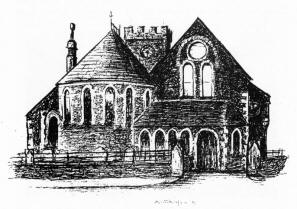

DROMORE OLD
MILL RACE
By Andrew Doloughan
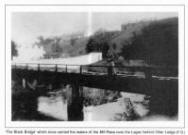 One
sometimes wonders how many of the rising generations in and
around Dromore are aware that within living memory there was
an old mill race which ran from the weir on the River Lagan
past Graham's yard, down Lower Mount Street on the opposite
side from the old Police Barracks. One
sometimes wonders how many of the rising generations in and
around Dromore are aware that within living memory there was
an old mill race which ran from the weir on the River Lagan
past Graham's yard, down Lower Mount Street on the opposite
side from the old Police Barracks.
This old race then crossed the lower side of The Square
and made its way under premises at the junction of Bridge
Street with Church Street to drive a corn mill wheel at the
bottom of what is still known as Hale's Entry.
When I chatted to fellow-townsman Mr. John McGrehan of
Meeting Street one evening he refreshed my memory about the
old race, recalling the time when, under an extensive road
improvement scheme in the town, it was piped and covered
over.
Johnny, as he is locally known, took a particular
interest in the race because the old hemstitching firm of
Hamilton McBride & Co. at Circular Road, where he spent the
whole of his working life, becoming a director, had at one
time tapped the race, bringing water across a wooden
aqueduct.
I was very interested to learn from Johnny that the
original proprietor of the firm, John Hamilton, locally
known as "Jakie," engineered the use of this aqueduct so
that it ran down the side of his garden at Otter Lodge and
drove two turbines at the factory - one for power and the
other for light.
Chuckling as he recalled the situation when there was a
flood on the river, Johnny explained that this reduced the
rate at which the water passed through the turbines with a
resultant drop in power.
When this occurred the machinists would shout "Steam up"
at Stanley Hill, the firm's mechanic, but of course he had
no control over the situation.
At the height of its career about 40 to 50 machinists
were employed in the firm which, in addition to
hemstitching, had its own laundry for bedspreads, pillow and
bolster cases, valances, tea cloths and tray cloths. They
had a washing machine and also a smoothing machine, known as
a calendar.
The managing director in those days was Howard Little,
and fellow directors with Johnny were Miss Margaret Murphy
and a man named Robert McCarthy.
If ever I knew this I had quite forgotten until Johnny
pointed out that on the staff at various stages were Miss
Rae Ervine, Billy Osborne and Brian Thompson.
Hemstitching Factories
The conversation then went on a tour of hemstitching
factories in the town in those days - Dromore Hemstitching
Co., Brewery Lane; the Bridge Hemstitching Co., Castle
Street; Wm. Jardine & Co. The Square (they also bleached and
dyed yarn at the Low Mills, on the Lurgan Road); John
Hamilton & Co's factory at The Square, and Murphy &
Stevenson's factory at Upper Church Street, at the entrance
to what is now the Town Park, and a factory run by the
Miniss family at Mossvale.

In our mind's eye we recalled some of the men who
controlled the running of these factories in years past, all
of them long since gone to their rest and reward - William
Dickson, J.P., and Edgar Saunders (Dromore Hemstitching
Co.), Charles M. Baxter, J.P., and his sons Charles and John
(Wm. Jardine & Co.), Frank Hamilton and afterwards his son
Roy (John Hamilton & Co.), Mr. Hutchinson (Murphy &
Stevenson), whose wife ran a millinery shop in Meeting
Street; William Sturgeon (The Bridge Hemstitching Co.). and
William George Baxter, of Princes Street, who was manager of
the Miniss firm, which supplied cambric handkerchiefs to
Queen Victoria.
For a time there was also a firm at Bridge Street, known
as the Downshire Frock Company, possibly because of the
Downshire Bridge further down the street. It was run by the
Spiro family.
And Johnny reminded me of another hemstitching factory at
Scott's Entry in Meeting Street, the manageress of which was
a Miss McCarthy.
We got down to talking about the changes that have taken
place in the old town over the years. Hardly a street that
has not been redeveloped, and many of the old hands have
passed away and new generations have taken their place.
The day was when one could have named most of the
householders in the various streets, but not so to-day.
Building development at places like Barban Hill, Banbridge
Road, Maypole Road, Milebush Road, Jubilee Road, Gallows
Street, Mound Road, Meeting Street, and Circular Road have
brought many new faces to the town. And, of course, new
generations of young folk have grown up.
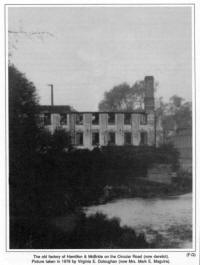
Funeral Customs of the Past
I do not wish to end on a sad note, but the conversation
turned to the days when coffins for local funerals used to
be made at the workshop of John and Willie Ellison at
Meeting Street, where William Moreland and Charlie Harrison
were both employed.
And on the day of a funeral the family provided the
officiating minister and the doctor with shoulder scarves,
while the bereaved wore crepe arm bands, and a crepe bow was
placed on the door knocker at the home of mourning.
To crown it all, hat bands were provided for the drivers
of the hearses - all horse-drawn vehicles.

Johnny has memories too of a custom in First Dromore
Presbyterian Church of the scarf worn by the minister at the
funeral during the week being placed the following Sunday
over a rail near the pulpit on whatever side in the Church
the deceased had his or her pew during their lifetime.
There are other much more pleasant events which happened
over the years in the town which Johnny, no doubt, can
recall, for having lived here all his life he has had ample
opportunity to observe much that took place down the years,
not only in his place of employment, but as a pillar of
First Dromore, where he sang in the choir, held office as
Sunday School superintendent and is still clerk of Session,
but also through his services on various school committees
and as a one-time chairman of the old Urban Council.
Johnny could also regale one about his early education at
the old School at First Dromore and later at the Technical
School firstly in Bridge Street and then in Upper Church
Street; and about the time when the "Master," the late
William George McAlister, was precentor in First Dromore
Choir, and stories of the days when the late reverend Rev.
Andrew Thompson was the minister and the late Todd Barr the
sexton.
Episode at an Auction
Both Johnny and I can recall Mr. McAlister taking a break
at night classes in the Tech to tell us about an auction
which took place in premises at the corner of Bridge Street
and Meeting Street and at which he was present.
Obviously the floor of the building was not capable of
coping with the large attendance, and it so happened that as
the auctioner's hammer fell to clinch the biddings one
corner of the floor gave way and many found themselves in a
heap.
Typically, in the next issue of the old "Dromore Weekly
Times" an article appeared from the pen of the editor and
proprietor, the late R. J. Hunter, B.L., in which he noted
that the precentor (Mr. McAlister did not lead them off in
singing: "Lord, from the depths to Thee we
cry.
Todd Barr was a real character, and I well remember him
telling me of an occasion on which he had spent some time
showing a visitor over First Dromore Church. The man was
leaving with a polite "Thank you," to be met with the quick
retort from Todd: "Don't mention it, my pockets are full of
thanks."
This leads me to record a similar incident attributed to
the late Alec Gribben, of Mount Street. Alec was a porter at
Dromore Railway Station, and, as the story was related to me
by one of his sons (the late Sam), after he had carried a
lot of baggage belonging to a passenger and had loaded it on
to a waiting vehicle, the passenger was about to leave when
Alec dropped a broad hint that he had received no gratuity.
"Sir," he said, "if you have lost your purse when you get
down town you hadn't it out at the station."
It strikes me that we don't have many characters like
Todd and Alec around these days.

MY FATHER THE
HORSEMAN
My father loved horses. He was particularly fond of the
great work-horses; the Shires and Clydesdales that worked
the fields and carted on the roads in his youth.
When they had out-lived their usefulness - made redundant by
the petrol engine - it broke his heart.
This poem is my tribute to my father, and to the horses that
he loved.
MY FATHER, THE HORSEMAN
by Roy Gamble
His hands remember;
Pallid on the eiderdown
Like peeled ash twigs,
Worked-grained thumbs
Playing peek-a-boo
With fissured palms
That still retain
The pluck and pull
Of reins or the steely
Feel of a sweat-polished
Horse plough.
Old age had made him nervous.
His bronchitic breath and cough
Has humped his back
(the way no furrow could)
And each forced word
Of conversation whistles
As if he paces
Some flint-faced hill
Or faces his team |
Into the season's
Stubborn wind.
From the cluttered mantle-shelf
He smiles at me,
Confident in rakish cap,
One arm casually embracing
A monster Clydesdale.
I search the sepia
For signs of recognition---
The common ancestry,
The shared birthright.
He sees me looking,
Eyes pleading, "That is me,
Remember me like that."
I understand and lean across
To touch his arm,
Fingers fumbling,
Too late to grasp
The obsolescent secrets
Of the horseman's hand. |
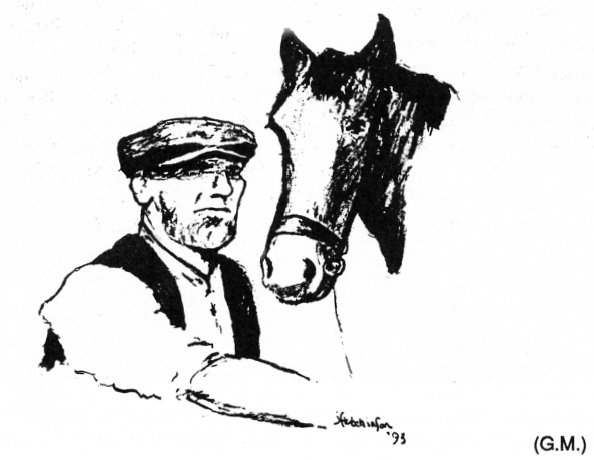

|